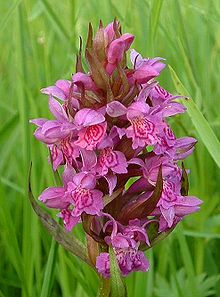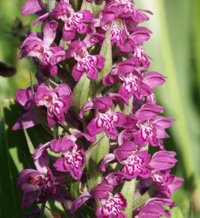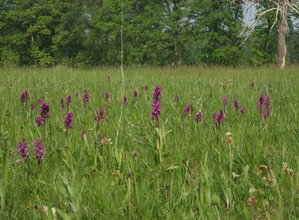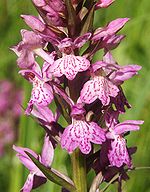- Western marsh orchid
-
Western marsh orchid 
Western marsh orchid (Dactylorhiza majalis) Scientific classification Kingdom: Plantae (unranked): Angiosperms (unranked): Monocots Order: Asparagales Family: Orchidaceae Subfamily: Orchidoideae Tribe: Orchideae Subtribe: Orchidinae Genus: Dactylorhiza Species: D. majalis Binomial name Dactylorhiza majalis
(Rchb.) P.F. Hunt & Summerh. 1965The western marsh orchid (Dactylorhiza majalis; also broad-leaved marsh orchid, fan orchid, common marsh orchid) is a terrestrial European orchid. Its flowering period begins at lower elevations as early as the beginning of May and ends in higher elevations at the end of July. The lowest blossoms usually open even before the stem has reached its full height.
The western marsh orchid grows mainly in nitrogen-poor marsh areas that consist of several plant communities. More rarely, it is found in fens.
Contents
Anatomy
The western marsh orchid is usually 15 to 40 cm (6 to 16 in.) tall, though some specimens may reach 60 cm (2 ft). Three to eight dark spotted leaves are distributed on the stem, which is hollow. The lower leaves are ovate to lanceolate and 6 to 18 cm (2⅜ to 7 in.) long and 1.5 to 3.5 cm (⅝ to 1⅜ in.) wide. The upper leaves are increasingly smaller and more lanceolate. The bracts are about as long as the blossom and cover it before it blooms. The densely flowered inflorescence, which is 4 to 15 cm (1½ to 6 in.) long, is at first conical, but distinctly cylindrical when in full blossom. The seven to forty blossoms are colored purplish red, rarely light pink or white. The lateral tepals of the external circle of the perianth stand obliquely or vertically upright. They are 7 to 12 mm (¼ to ½ in.) long and 2.5 to 5 mm (⅛ to 3⁄16 in.) wide. The middle tepal is smaller and forms a "helmet" together with the two lateral tepals of the internal circle. These are 6 to 11 mm (¼ to 7⁄16 in.) long. The trilobate lip is 5 to 10 mm (3⁄16 to ⅜ in.) long and 7 to 14 mm (¼ to 9⁄16 in.) wide. The shape and pattern of the lips are variable. In the lighter central area of the lip the markings are made up of lines, streaks, or dots. The spur is bent slightly downwards and is not quite as long as the ovary. The tuber has a palmate division and an irregular shape.
The western marsh orchid has a karyotype of two sets of forty chromosomes. The seed of this orchid contains no endosperm for the embryo. Therefore, germination can take place only by means of infection with a root fungus (mycorrhiza).
Range
The range extends in Europe from the Pyrenees to the Baltic and to the Don, possible even to the Volga. The western marsh orchid is not found south of the Alps and is rare in southern Scandinavia.
In Germany the western marsh orchid is widespread but with several gaps. In many places, especially from western to northern Germany, it is extinct.
In Switzerland the western marsh orchid is also quite widespread. A significant gap is found south of the Aar between Aarau and Lake Neuchâtel.
Conservation and endangerment
Although the western marsh orchid is commonly found in some regions, it is nevertheless protected as an orchid.
As with many marsh plants, the numbers of this species have been dwindling for quite some time. The main causes are the entry of nitrogen via fertilizer, drying out of the habitat, and intensive conversion to pasture. The western marsh orchid does not react so sensitively to changes in its habitat as for example the early marsh orchid. It is usually the last of the native orchids to disappear. This tolerance makes it a still relatively common species.
Varieties and hybrids
- Variety:
- Dactylorhiza majalis var. pumila (Synonym: Dactylorhiza majalis var. alpestris), an Alpine variety.
- Hybrids:
- The western marsh orchid hybridizes quite commonly with other species of its genus.
- Dactylorhiza × aschersoniana (incarnata × majalis)
- Dactylorhiza × braunii (fuchsii × majalis)
- Dactylorhiza × dufftiana (majalis × traunsteineri)
- Dactylorhiza × godferyana (majalis × praetermissa)
- Dactylorhiza × kuehnensis (majalis × ruthei
- Dactylorhiza × townsendiana (maculata × majalis)
- Dactylorhiza × rupertii (majalis × sambucina)
- More rarely hybrids with other genera (intergeneric hyrids) occur.
- ×Dactyloglossum drucei (Coeloglossum viride ×Dactylorhiza majalis)
- ×Dactylodenia lebrunii (Dactylorhiza majalis × Gymnadenia conopsea)
Classification
In 1828 Ludwig Reichenbach described the western marsh orchid as Orchis majalis. The name became the basionym after Peter Francis Hunt and Victor Samuel Summerhayes transferred the species to the genus Dactylorhiza in 1965. Sometimes the name Dactylorhiza fistulosa is used, but since this description is not valid, the name cannot be used despite its earlier publication in 1794 as Orchis fistulosa.
Synonyms:
- Orchis majalis Rchb. 1828 (basionym)
- Dactylorchis majalis (Rchb.) Verm. 1947
- Dactylorhiza comosa ssp. majalis (Rchb.) P.D. Sell & G.Murrell 1996
- Orchis fistulosa Moench 1794 nom. illeg.
- Dactylorhiza fistulosa (Moench) H. Baumann & Künkele 1983 nom. illeg.
This article incorporates text translated from the corresponding German and French Wikipedia articles as of 4 February 2006.
Western marsh orchid (1989) | Pyramidal orchid (1990) | Green-winged Orchid (1991) | Listera ovata (1992) | Military Orchid (1993) | Fen orchid (1994) | Bee Orchid (1995) | Cypripedium calceolus (1996) | Bug Orchid (1997) | Marsh Helleborine (1998) | Lizard Orchid (1999) | Red Helleborine (2000) | Autumn Ladies'-tresses (2001) | Bird's-nest Orchid (2002) | Fly Orchid (2003) | Frog Orchid (2004) | Burnt orchid (2005) | Broadleaf Helleborine (2006) | Southern Marsh Orchid (2008) | Early Purple Orchid (2009) | Cypripedium calceolus (2010) |Categories:- Orchid species
- Orchidoideae
- Dactylorhiza
- Variety:
Wikimedia Foundation. 2010.





